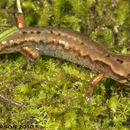Description
provided by AmphibiaWeb articles
Desmognathus wrighti is a relatively small species of salamander that can be distinguished by a broad, reddish-brown dorsal band. This coloration can bleed down into the ventral region, although this area can also be unpigmented. The regions around the heart and eyes are usually colored by gold pigments, and the lower jaw is heavily spotted with reddish-brown to gold colors. This species ranges in length from 17-20 mm (SVL) in both males and females, and has a relatively short tail in comparison with body length. D. wrighti individuals hatch without gills. Unlike adult individuals, young D. wrighti have well-defined paravertabral spots (Harrison 2000).Etymology. Desmognathus wrighti was named in honor of George M. Wright who served as a former Chief of the Wildlife Division in the National Park Service (Harrison 2000).
- Bruce, R. C. (1977). ''They pygmy salamander, Desmognathus wrighti (Amphibia, Urodela, Plethodontidae), in the Cowee Mountains, North Carolina.'' Journal of Herpetology, (11), 246-247.
- Hairston, N. G. (1949). ''The local distribution and ecology of the plethodontid salamanders of the southern Appalachians.'' Ecological Monographs, 19(1), 497-73.
- Harrison, J.R., III (2000). ''Desmognathus wrighti.'' Catalogue of American Amphibians and Reptiles. Society for the Study of Amphibians and Reptiles, 704.1-704.7.
- Huheey, J. E. (1966). ''A new salamander (Desmognathus) from the southern Appalachians.'' Herpetologica, (1), 57-60 + 1 pl.
- Rubin, D. (1971). ''Desmognathus aeneus and D. wrighti on Wayah Bald.'' Journal of Herpetology, 5, 66-67.
- Tilley, S. G. and Harrison, J. R. (1969). ''Notes on the distribution of the pygmy salamander king, Desmognathus wrighti.'' Herpetologica, (29), 178-180.
Distribution and Habitat
provided by AmphibiaWeb articles
Country distribution from AmphibiaWeb's database: United States Isolated populations of Desmognathus wrighti are found primarily at high elevations in the forested areas of southwestern Virginia, western North Carolina, and eastern Tennessee. Although this species is normally found in spruce-fir forests at elevations of 762-2082 m, small groups of D. wrighti have been documented in mesophytic hardwood forests. Huheey (1966), Tilley, Harrison (1969), Rubin (1971), and Bruce (1977) claim that the populations living east and south of the current spruce-fir forest ranges could be indicative of a former more wide-spread distribution. This species prefers spruce-fir forests, where it can find moist environments under small logs and stones. Hairston (1949) observed that 76% of the individuals he studied were located about 200 feet from a direct water source such as a stream. The ability of D. wrighti to survive in drier conditions is also demonstrated in its vertical distribution. In excessively moist conditions, this species can be found on the leaves of trees up to seven feet above the ground. At high elevations, D. wrighti usually lives under the tight-fitting bark of stumps or trees (Harrison, 2000).
Life History, Abundance, Activity, and Special Behaviors
provided by AmphibiaWeb articles
During the fall, Desmognathus wrighti moves from forested areas to underground seepages, where it remains in hybernation throughout the winter. This species of salamander does not have an aquatic larval stage; D. wrighti is mainly a terrestrial species (see Distribution). According to Hairston (1949), D. wrighti is active during periods of complete darkness.

